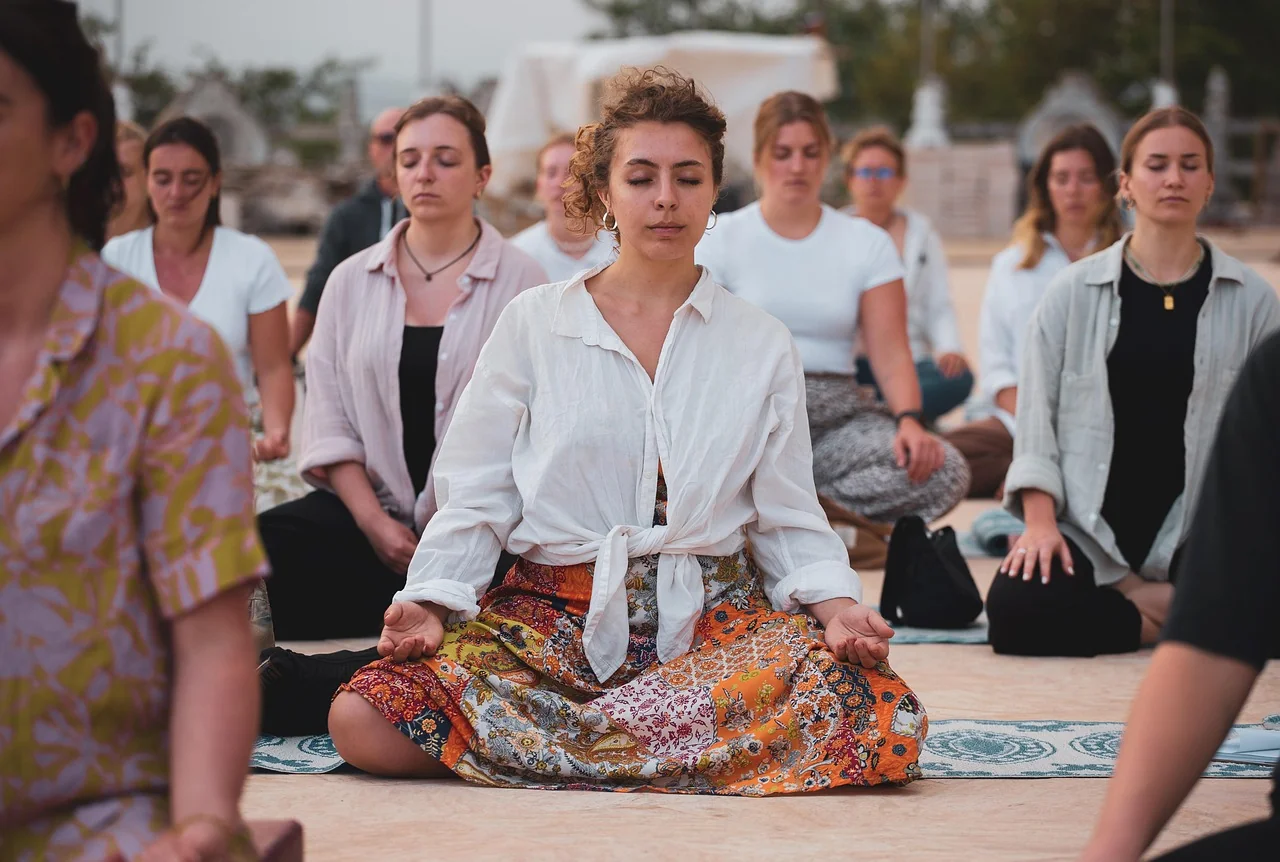Feeling like your to-do list is a mile long and your patience is worn thin? In our non-stop world, the idea of finding time for self-care can feel like just another item on that overwhelming list. You know you should meditate, but who has 30 spare minutes? This is where the power of a 5 minute meditation script changes everything.
Think of it as a mental reset button—a short, guided pause that can halt the cycle of stress and bring you back to the present moment. This isn't about achieving perfection or emptying your mind; it's about gifting yourself a manageable, powerful tool for instant calm. In the next few minutes, you'll discover not only the surprising benefits of a brief practice but also a simple, step-by-step script you can use immediately to anchor your day, reduce anxiety, and build a sustainable mindfulness habit that actually fits your busy life.
The Surprising Power of a 5-Minute Meditation Practice
You might be skeptical. In a world buzzing with complex solutions, can just five minutes of quiet really make a dent in your stress levels? The resounding answer from neuroscience and experienced practitioners alike is yes. The power of a short guided meditation script isn't in marathon sessions of deep contemplation; it's in the consistent, daily reinforcement of a calmer state of being.
Your nervous system doesn't need an hour to begin shifting gears. When you feel stressed or anxious, your body is flooded with hormones like cortisol and adrenaline, priming you for a "fight-or-flight" response. This is incredibly useful in a genuine crisis, but modern life often triggers it unnecessarily. A quick meditation acts as a direct counter-signal. By intentionally focusing on your breath and body, you activate the parasympathetic nervous system—your body's "rest and digest" mode. This begins to lower your heart rate, reduce blood pressure, and calm the mind, all within a few minutes.
The true magic, however, lies in consistency and accessibility. For most people with demanding schedules, a 30-minute meditation session feels like an impossible commitment. It's easy to skip, feel guilty about, and eventually abandon. A five-minute practice, on the other hand, is far less intimidating. It’s a manageable commitment that you’re much more likely to stick with day after day. For a comprehensive look at building this routine, our 5 minute daily meditation guide is a great resource.
This consistent practice is what builds neuroplasticity—your brain's ability to rewire itself. Each time you gently guide your attention back from a distracting thought to your breath, you are strengthening the neural pathways associated with focus and emotional regulation. Over time, this daily meditation practice doesn't just help you during the five minutes you're sitting quietly; it builds a foundational resilience that you carry into the rest of your day.
Think of your 5-minute meditation script as an anchor. You can use it to:
- Ground yourself before a stressful work meeting or presentation.
- Create a clear transition between work mode and home life.
- Center your mind upon waking, setting a positive tone for the day.
- Release the day's tensions before sleep.
- Simply hit a "reset button" during any moment of overwhelm.
Preparing for Your Practice: Setting the Stage for Success
The beauty of a short meditation script is its simplicity and flexibility. You don't need a special room, expensive equipment, or hours of free time. With just a little preparation, you can create an ideal environment for your practice to flourish.
Finding Your Space You don't need a perfectly silent, dedicated meditation room. Simply find a relatively quiet spot where you are unlikely to be interrupted for a few minutes. This could be your office chair before work begins, a park bench during your lunch break, a corner of your living room, or even your bed. The goal is consistency, not perfection.
Timing is Everything Consistency is more important than the specific time of day. However, many people find it helpful to attach their new habit to an existing one. Consider these popular times:
- Morning: To set a calm, intentional tone for your day. A perfect companion for this is a 5 minute morning meditation #gratitude to start with positivity.
- Lunch Break: To reset and recharge before tackling the afternoon.
- Evening: To decompress and process the day's events, leading to better sleep.
Experiment to find what works best for your rhythm. The most effective time is the one you can consistently commit to.
Posture & Comfort The ideal posture is one that is both alert and relaxed. You are not trying to fall asleep, but you also don't want to be so rigid that you create tension.
- Sitting in a Chair: Sit with your feet flat on the floor and your back straight, not leaning against the chair back. Rest your hands comfortably on your knees or in your lap.
- Sitting on the Floor: Use a cushion to elevate your hips slightly, allowing your knees to comfortably rest lower than your hips. Cross your legs comfortably.
- Lying Down: If you are meditating before sleep or have back issues, you can lie on your back with your arms by your sides. Be aware that this position can sometimes lead to drowsiness.
The key is to keep your spine in a natural, upright alignment to support alertness.
Minimizing Distractions Take one minute to set yourself up for success.
- Silence your phone or put it in another room.
- If others are around, let them know you need five minutes of uninterrupted time.
- Dim the lights slightly if it helps you relax.
Your Core 5 Minute Meditation Script for Beginners
This 5-minute meditation script is designed to be your go-to guide. It follows a simple, effective structure: grounding into your body, scanning for sensations, anchoring with the breath, and expanding your awareness before gently returning. You can read it through once to familiarize yourself, then try it from memory, or read one section at a time, pausing to follow the instructions.
Find your comfortable, alert posture. Gently allow your eyes to close, or if you prefer, soften your gaze downward.
(Minute 1: Arrival & Grounding)
Begin by bringing your attention to the physical sensations of your body sitting here. Notice the points of contact: your feet on the floor, your body making contact with the chair or cushion. Feel the weight of your body being fully supported.
Acknowledge the environment around you. Notice any sounds you can hear, both near and far. You don't need to judge them as good or bad—simply let them be, just as they are. With your next inhalation, draw your awareness fully inward, into the container of your own body. With your exhalation, release any obvious physical tension you're holding in your shoulders or jaw. Give yourself full permission to be right here, in this moment, with nothing else to do.
(Minute 2: The Body Scan)
Now, bring your attention to the very top of your head. In your mind's eye, slowly begin to scan down through your body. Notice any sensations you find—warmth, coolness, tingling, pressure, or perhaps no distinct sensation at all. That’s perfectly fine.
Move your awareness down through your forehead, your eyes, and your jaw. Down through your neck and into your shoulders. Notice your arms and hands, and the sensation of your hands resting. Bring your attention to your chest and abdomen, noticing the gentle rise and fall with each breath. Scan down through your lower back, your hips, and into your legs. Finally, arrive at your feet, feeling them fully connected to the floor. For a few moments, hold a sense of your entire body, breathing and alive, all at once.
(Minute 3: Anchoring with the Breath)
Now, gently let go of the body scan and bring the spotlight of your attention to your natural breath. There is no need to force or control it. Simply notice the rhythm of your breathing.
Find one specific point where the sensation of the breath feels most distinct. This might be:
- The cool air entering your nostrils and the warmer air leaving.
- The rise and fall of your chest.
- The expansion and contraction of your abdomen.
Choose one of these anchors and rest your attention there. With each inhale, simply notice the sensation of inhaling. With each exhale, notice the sensation of exhaling. Your mind will naturally wander—this is not a mistake, it is the practice. When you notice your attention has drifted to a thought, sound, or plan, gently and without judgment, guide it back to the sensation of your very next breath.
(Minute 4: Expanding Awareness)
As you continue to feel the anchor of your breath, allow your awareness to gently expand. Include the sense of your whole body sitting and breathing once again. Become aware of the space around you, the air on your skin.
Notice if any thoughts are present. Imagine them as clouds passing through the vast sky of your awareness. You don't need to stop the clouds or follow them; just let them drift by. Notice any emotions that may be present, again, without needing to change them. Simply rest in this open, accepting awareness for this final minute, holding everything—your breath, your body, your thoughts—in a gentle, compassionate space.
(Minute 5: Returning & Transitioning)
Begin to gently bring your awareness back. Slowly start to wiggle your fingers and your toes, bringing movement back into the body. Notice how you feel in this moment.
When you feel ready, slowly and gently open your eyes, if they were closed. Take a moment to look around the room, noticing the light, colors, and shapes. Before you jump up, set a simple intention to carry this small pocket of calm with you into the next part of your day. Move slowly and mindfully as you transition from your practice.
Tips for Making Your 5-Minute Meditation a Daily Habit
Building a new habit requires a gentle strategy, not sheer willpower. The goal is to make your practice so effortless and rewarding that it automatically becomes part of your daily routine.
- Start Small and Be Consistent: Commit to just five minutes a day. It's better to practice for five minutes every day than for thirty minutes once a week. Consistency builds the habit loop in your brain.
- Use a Habit Stack: Link your meditation to an existing habit. For example, "After I pour my morning coffee, I will meditate for five minutes," or "Right before I check my email after lunch, I will do my quick meditation." This piggybacks on a neural pathway that's already well-established.
- Be Kind to Your Wandering Mind: The single most important tip is to let go of judgment. When you notice your mind has wandered (and it will, hundreds of times), that moment of noticing is a moment of mindfulness—it is the win. Gently guide your attention back without criticizing yourself. This is the core of the practice.
- Use a Timer: A gentle timer bell can free you from clock-watching. Set a timer for five minutes with a soft, non-abrupt sound to signal the end. Many meditation apps offer this feature.
- Track Your Progress: Use a habit tracker on your phone or a simple calendar. Mark an "X" for each day you meditate. This visual record can be highly motivating and help you build a "chain" you won't want to break.
- Find a Buddy: Share your goal with a friend or family member. Checking in with someone about your daily meditation practice can provide accountability and support.
Adapting Your Script: Next Steps in Your Mindfulness Journey
Once you feel comfortable with this core 5-minute meditation script, you can begin to adapt it to your specific needs. This keeps your practice fresh and allows you to develop different mindfulness muscles.
For Deeper Focus: Instead of a general body scan, spend the entire five minutes focusing exclusively on the subtle sensations of the breath at your chosen anchor point. Each time the mind wanders, patiently return. This is a powerful concentration practice.
For Managing Anxiety: When feeling anxious, place a hand on your heart and another on your belly. Follow the script, but spend extra time feeling the physical sensation of your hands on your body and the gentle movement of your breath under your hands. This tactile feedback can be incredibly grounding. For moments when you need immediate relief, this free 5 minute meditation for instant calm & focus is a great tool.
For Cultivating Gratitude: During the final minute of expanding awareness, bring to mind one simple thing you are grateful for. It could be the warmth of the sun, a comfortable chair, or a loved one. Hold that feeling of gratitude in your awareness, letting it soak into your body. To dive deeper into this practice, explore our 5 minute loving-kindness meditation guide.
Exploring Further: Your 5 minute meditation script is a perfect gateway. As your comfort grows, you might explore:
- Longer Sessions: Gradually extend your practice to 10, 15, or 20 minutes.
- Guided Meditations: Use apps or online audio recordings to explore different styles, like loving-kindness meditation or body scan meditations. For a different approach to unwinding, you can try this guided meditation script for relaxation.
- Mindfulness in Daily Life: Start to bring small moments of mindfulness into your day—truly tasting your food, feeling the water on your hands while washing dishes, or taking one mindful breath before answering the phone.
This simple script is more than just words; it's a practical tool for reclaiming your focus and peace in a busy world. By dedicating just five minutes a day, you are investing in your long-term well-being, building a foundation of calm that can support you through anything life brings your way.
In conclusion, integrating a five-minute meditation into your daily routine is a profoundly accessible and powerful step toward greater mental clarity and emotional balance. This practice requires no special equipment or extensive training, proving that the benefits of meditation—reduced stress, enhanced focus, and a calmer nervous system—are within everyone's reach. The key is consistency, not duration; a brief, daily commitment can forge significant, lasting change. The script provided offers a structured starting point, a simple tool to quiet the mind and reconnect with the present moment amidst life's inevitable chaos. Let this be your invitation to pause, breathe, and reset. Begin today, and discover how a few mindful minutes can transform the tone of your entire day, building a foundation of resilience and peace that supports all other aspects of your life. Your journey toward a more centered self starts with a single, conscious breath.


